|
|
|
Sort Order |
|
|
|
Items / Page
|
|
|
|
|
|
|
| Srl | Item |
| 1 |
ID:
159378
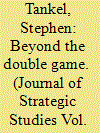

|
|
|
|
|
| Summary/Abstract |
States commonly take one of three approaches to militant groups on their soil: collaboration; benign neglect; or belligerence. All three approaches are present in Pakistan, where some groups also move back and forth among these categories. I employ the term “coopetition” to capture this fluidity. The dynamic nature of militancy in Pakistan makes the country an excellent laboratory for exploring a state’s assessment of the utility an Islamist militant group offers, and the threat it poses relative to other threats informs the state’s treatment of that group. In this article, I put forward a typology that situates Islamist militants in Pakistan in one of the above four categories. I also illustrate how a group’s identity, objectives, and alliances inform assessments of its utility and threat relative to other threats. In addition to enhancing our understanding of militant–state dynamics, this taxonomy builds on and helps to unify earlier typologies of Pakistani militancy.
|
|
|
|
|
|
|
|
|
|
|
|
|
|
|
|
| 2 |
ID:
130929
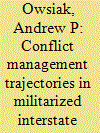

|
|
|
|
|
| Publication |
2014.
|
| Summary/Abstract |
When multiple third parties intervene diplomatically in the same dispute, are their interventions interdependent? Although theoretical and empirical evidence suggests that they are, most conflict management research fails to theorize about and model this interdependence directly. The current project breaks with this tradition by advancing the new concept of a conflict management trajectory-the idea that conflict management efforts evolve over the course of a conflict and successive efforts inform one another. After discussing the rationale for and theoretical foundations underlying trajectories, I construct these trajectories empirically, summarize and discuss some of their characteristics, and create a typology to describe and organize them. In the process, I demonstrate that trajectories possess properties that clearly differentiate them from isolated interventions (the alternative) and display numerous general patterns. Each of these, in turn, suggests that trajectories deserve greater study as we seek to integrate and expand our understanding of international conflict management.
|
|
|
|
|
|
|
|
|
|
|
|
|
|
|
|
| 3 |
ID:
090693
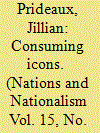

|
|
|
|
|
| Publication |
2009.
|
| Summary/Abstract |
In extension of Billig's (1995) and Edensor's (2002) contribution to the literature, this paper examines an often overlooked element in 'mundane' nationalism, company advertising. Through the development of a typology of advertising strategies, it examines the role of companies as nationalist actors, and highlights how advertisements can engage with and impact on wider national discourses. Nationalist company advertising is classified into types, depending on how associated the company is with nationalism in popular discourse, and whether the advertising campaign involves the company's participation in broader nationalistic political projects. The types developed in this typology include (1) 'ordinary marketing/achieving nationalist credentials', (2) 'ordinary marketing/established nationalist credentials' and (3) 'activist marketing/achieving nationalist credentials'. Case studies from the Australian context are used to illustrate these types, how the different types use nationalism, and their varying impact on shaping wider nationalistic discourses.
|
|
|
|
|
|
|
|
|
|
|
|
|
|
|
|
| 4 |
ID:
140328
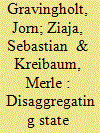

|
|
|
|
|
| Summary/Abstract |
This conceptual and methodological article makes the case for a multidimensional empirical typology of state fragility. It presents a framework that defines fragile statehood as deficiencies in one or more of the core functions of the state: authority, capacity and legitimacy. Unlike available indices of state fragility, it suggests a route towards operationalisation that maintains this multidimensionality. The methodology presented should help in future research to identify clusters of countries that exhibit similar constellations of statehood, whereby ‘constellation’ refers to the specific mix of characteristics across the three dimensions. Such an identification of empirical types would fulfil a demand that exists both in academic research and among policy circles for finding a more realistic model of fragility at an intermediate level between single-case analyses and the far-too-broad category of state fragility.
|
|
|
|
|
|
|
|
|
|
|
|
|
|
|
|
| 5 |
ID:
109165
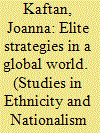

|
|
|
|
|
| Publication |
2011.
|
| Summary/Abstract |
This study focuses on how Polish elites view the relationship between Polish identity and Poland's place in the world. Samples of priests, politicians, and intellectuals were interviewed in 1999 and 2009. A typology of four ideal types is proposed: ideological nationals, pragmatic nationals, pragmatic transnationals, and ideological transnationals. This typology can be viewed as a continuum of elite emphasis ranging between national and transnational themes. This continuum of emphasis can be seen when examining elite responses to questions concerning NATO membership, EU membership, Polish identity, and Polish democracy. This study finds that while the majority of Polish priests and politicians wished to emphasise national over transnational themes, intellectuals stressed transnational themes. Nevertheless, most acknowledged the inseparable nature of these themes when they talked about the contemporary Polish nation.
|
|
|
|
|
|
|
|
|
|
|
|
|
|
|
|
| 6 |
ID:
130231
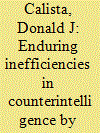

|
|
|
|
|
| Publication |
2014.
|
| Summary/Abstract |
A lot of time we are chasing shadows, but it's better to do that than find out later you let something get by. (An FBI field agent-Type I Error or a false positive). 1
The best chance for success [terrorists] have is to get somebody who is not a visitor [to] come in as a permanent resident or citizen, who knows the culture and how to move around, who doesn't have a record, so as not to get picked up by a database. (A former senior U.S. intelligence official-Type II Error or a false negative). 2
These two citations reflect divergent responses to the governance structures of terror organizations that continue to be subjects of interest and debate among scholars and practitioners. The operational character of terrorism remains essential to the development of strategic initiatives by counterintelligence (CI) agencies. To position CI more advantageously certain concepts from New Institutional Economics (NIE) might be utilized. 3 NIE's central formulation of principals and agents assumes that people make rational choices in determining whether to plan their transactions (relationship costs) into one of two kinds of configurations: market (decentralized) versus non-market (centralized) endeavors. Effectively, the challenge is to determine which transactional method offers greater prospects to achieve efficiency. Inherent limitations (externalities) of time, place and resources complicate these choices. Those involved can be divided into owners (principals) and workers or suppliers (agents). In fulfilling any agreed upon duties, transaction costs then center on the degree to which principals undertake monitoring the behavior of agents for possible shirking-referenced by NIE as the "agency problem."
|
|
|
|
|
|
|
|
|
|
|
|
|
|
|
|
| 7 |
ID:
140276
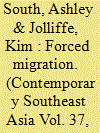

|
|
|
|
|
| Summary/Abstract |
Ethnic armed conflict has plagued southeast Myanmar for over sixty-five years, and has been the cause of significant and repeated episodes of forced migration. The dynamics of forced migration have undergone profound changes in the region since 2012, following the signing of bilateral ceasefire agreements between the government and several Ethnic Armed Groups (EAGs). Within this context, this article describes and analyses the decision-making processes and approaches to return, resettlement and rehabilitation of forced migrants — Internally Displaced People (IDPs) and refugees. In relation to academic and policy literatures on local agency and humanitarian protection, we argue that forced migrants in and from Myanmar demonstrate great resilience and significant capacities for self-protection and that external support should be geared towards supporting local coping strategies and attempts to achieve dignified and “durable solutions” to their plight. This approach requires an in-depth exploration of local contexts, and forced migrants’ decision-making processes. We present a typology of conflict-induced forced migrants in and from southeast Myanmar, followed by an analysis of five main factors that influence their decisions, and help to explain some of the key differences between different types.
|
|
|
|
|
|
|
|
|
|
|
|
|
|
|
|
| 8 |
ID:
150013
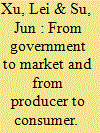

|
|
|
|
|
| Summary/Abstract |
This paper proposes a new typology that classifies innovation policy instruments into two dimensions: government-selection versus market-selection, and producer-orientation versus consumer-orientation. Such a typology articulates the importance of consumer behavior in the policy design for a transition, and the relevance for the market to select target subjects of policy during the deployment stage of clean technology innovation. We apply this typology to policy instruments of China's new energy vehicle (NEV) industry between 1991 and 2015 in order to explain the industry's rapid growth. The focus of China's policy mix has transited from government-selection to market-selection, and from producer-orientation to consumer-orientation. Other than the new typology, this paper traces the entire history of policy transition within China's NEV industry, and finds the transition to be a result of policy learning, thus contributing to future empirical studies of this industry.
|
|
|
|
|
|
|
|
|
|
|
|
|
|
|
|
| 9 |
ID:
191624


|
|
|
|
|
| Summary/Abstract |
This article focuses on contemporary Salafism in the European context and how it speaks to the categories Wiktorowicz put forth in his seminal 2006 article. Specifically, it examines how we can identify, describe, and classify the main forms of Salafist religiosity in the context of Western European countries. Furthermore, by examining the relationship to politics, preaching, and orthodoxy and orthopraxy in several European societies, this analysis contributes to the debate on the typologies of Salafism and proposes new ways of conceiving and distinguishing the forms of attachment to this vision of Islam in the context of countries where this religion is a minority. It also shows that the fundamentalist and radical currents are even more attached to it despite or because of the strong attention they receive from the public authorities and the media.
|
|
|
|
|
|
|
|
|
|
|
|
|
|
|
|
| 10 |
ID:
180017
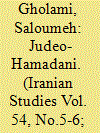

|
|
|
|
|
| Summary/Abstract |
The study of the language of religious minorities in Iran is particularly important for understanding the historical development and typology of Iranian languages. Historical and linguistic evidence substantiates the idea that Zoroastrians and Jews in cities in central and western Iran preserved their former vernacular language, whereas the majority of the population replaced it with Persian in the New Iranian period. This paper focuses on the language of Jews in Hamadan and has two main objectives: first, it examines numerous distinctive features of Judeo-Hamadani; second, it reviews and updates recent research to clarify the language origins, using data from new materials recorded during fieldwork in Hamadan from October 2018 to August 2019, and in Yazd in 2017.
|
|
|
|
|
|
|
|
|
|
|
|
|
|
|
|
| 11 |
ID:
105644


|
|
|
|
|
| Publication |
2011.
|
| Summary/Abstract |
This article is concerned with a particular debate in mediation literature, revolving around the merit and necessity of power as a strategy employed by third parties in their efforts to negotiate a successful resolution to conflict. We argue that by subscribing to a one-dimensional spectrum of pure-to-power mediation, students of mediation have neglected the development of how power is conceptualised and operates within the changing dynamics of conflict and its mediation.
We therefore seek to redefine the concept of power mediation to project a closer fit between conflicting parties' understanding of their situation and the methods, aims and motivations of their mediators. Breaking away from the existing pure-power spectrum, we propose a heuristic framework that includes four distinct types of power mediation, defined here as real, made, critical and structural power. The contribution of our heuristic model is threefold. First, it assists us in asking the most basic question of social science research, 'of what is this a case', which in turn ought to lead to a more sophisticated observation of mediation instances. Concurrently, through the frame of 'power', it establishes common understanding of observable phenomena that makes the study of mediation more accessible to the wider audience beyond students of our modest literature. Finally, the synthesis of epistemological and ontological inquiry of conflict and power with the established International Relations (IR) approaches of realism(s), constructivism, critical discourse and structuralism, allows respective real, made, critical and structural types of mediation power to be tested.
|
|
|
|
|
|
|
|
|
|
|
|
|
|
|
|
| 12 |
ID:
177669
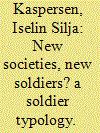

|
|
|
|
|
| Summary/Abstract |
The term ‘soldier’ is frequently conceptualized as a warrior, a peacekeeper, or a hybrid of both. However, recent changes in the utilization of soldiers in societies have moved the repertoire of possible ways to think, act, and behave beyond these notions. As such, there exists an undertheorized gap between different expectations of soldiers and actual soldier roles. This presents a need for more nuanced and analytically useful conceptualizations of soldier roles. This article provides a more thorough understanding of the soldier role by identifying seven ideal types of soldiers: the warrior, nation-defender, law-enforcer, humanitarian, state-builder, and the ideological, and contractor soldiers. The typology offers an analytical tool with the capacity to maneuver the empirical reality, which is important because how soldier roles are constructed affect how military personnel understand their role in the postmodern world, where identity is multifaceted and negotiable. Ultimately, identity influences how soldiers interact with societies and how societies respond to war, conflicts, and crises.
|
|
|
|
|
|
|
|
|
|
|
|
|
|
|
|
| 13 |
ID:
084255
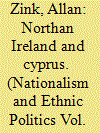

|
|
|
| 14 |
ID:
142567


|
|
|
|
|
| Summary/Abstract |
The implementation of China's reform era target-based cadre evaluation system has instigated various types of gaming behaviour on the part of local officials. How do these gaming strategies differ from each other? Why do local officials sacrifice the public interest for target fulfilment in some cases but not in others? This article argues that gaming is not monolithic and should not be treated as such. It develops a typology that distinguishes between pernicious and benign gaming, and looks into the symptoms and motives of pernicious gaming in particular. It finds that the distinct design of the measurement system – the combination of result-oriented targets imposed from above and high-powered incentives for target fulfilment – induces pernicious gaming. In addition, the system's implementation practically compels local officials to misrepresent their performance, even though they are aware of the negative impact of such behaviour on the public interest. This study shows that to understand the strategies, motivations and implications of gaming better, a more nuanced approach is needed.
|
|
|
|
|
|
|
|
|
|
|
|
|
|
|
|
| 15 |
ID:
131708
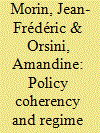

|
|
|
|
|
| Publication |
2014.
|
| Summary/Abstract |
This study argues that 'regime complexes' and 'policy coherence' are two faces of the same integrative process. The development of regime complexes co-evolves with the pressures on decision makers to coordinate their policies in various issue-areas. Conceptually, we introduce a typology of policy coherency (erratic, strategic, functionalistic, and systemic) according to its procedural and substantive components. Empirically, by triangulating quantitative and qualitative data, we use this typology for the case of the genetic resources' regime complex to illustrate the links between regime complexes and policy coherency. Our results suggest that a coherent policymaking process favours integrated regime complexes, while greater exposure to a regime complex increases the pressure to have a coherent policymaking. This study fills a gap in the literature on regime complexes by providing a micro-macro model linking structure to agency.
|
|
|
|
|
|
|
|
|
|
|
|
|
|
|
|
| 16 |
ID:
190057
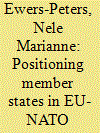

|
|
|
|
|
| Summary/Abstract |
With the growing density and the plethora of security organisations on the regional and international level, the research programme on interorganisational relations has received increasing scholarly attention. The complexity of European security – in light of the Ukraine conflict since 2014, Russia’s more assertive foreign policy behaviour, and on-going crisis management operations in the Africa, the Mediterranean Sea and Middle East – has revived EU-NATO cooperation. The analysis from the perspective of member states and how they can be positioned in the EU-NATO interorganisational relations, however, has received little exploration. This article, therefore, addresses the roles and positions of member states within the relations between the EU and NATO as Europe’s prime security organisations. Member states have numerous political strategies at their disposal to trigger, strengthen or obstruct interorganisational relations, ranging from forum-shopping to hostage-taking and brokering. Drawing on insights from regime theory, network analysis, organisation theory and interorganisationalism, this article proposes a typology of member states in EU-NATO cooperation. Against the backdrop of this special relationship, the typology is developed which aims to detect and illustrate member states’ positions and strategies.
|
|
|
|
|
|
|
|
|
|
|
|
|
|
|
|
| 17 |
ID:
117916
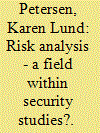

|
|
|
|
|
| Publication |
2012.
|
| Summary/Abstract |
The academic environments of risk analysis and security studies had hardly 'spoken' to one another until recently. The two fields of study were defined within different academic disciplines: security studies a matter for International Relations (IR), and risk studies a matter for sociology, economics and the natural sciences. Increased focus on catastrophic events (terrorism, climate change, etc.) seems to have given the fields of security studies and risk analysis a common empirical theme and highlighted the need for a common research agenda. This article explores the intersection between these two fields of study, as it investigates how the 'old' disciplinary debates on risk have been translated 'into' security studies - to predict, criticize or evaluate the current political practice of security. Such analysis provides a much-needed overview of the risk debates within security studies and brings out the limits of this debate in light of the broader and much more historically settled risk debates within sociology, economics and anthropology.
|
|
|
|
|
|
|
|
|
|
|
|
|
|
|
|
| 18 |
ID:
165247
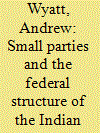

|
|
|
|
|
| Summary/Abstract |
Political parties have proliferated in India since the 1980s. A marked feature of the growth of parties has been the competitiveness of regional parties. Political entrepreneurs have broken away from established parties and formed separate parties that have competed at both state and national levels of the Indian political system. A few of the newly formed parties became strong competitors in their home units, sometimes leading state governments, demonstrating that they were large parties in their own region. A larger number of regional parties won representation in the Lok Sabha after 1989, but most of these newer parties, and some of the older ones, remained small. In the context of coalition politics many small parties were welcomed into national coalitions. Yet a lack of Assembly seats usually resulted in small parties being excluded from government at the state level. This article develops a typology that distinguishes small parties, active in national and state elections, from the larger regional parties and the hundreds of smaller parties registered with the Election Commission. The wider significance of the small parties is assessed in relation to party system change and the everyday conduct of politics.
|
|
|
|
|
|
|
|
|
|
|
|
|
|
|
|
| 19 |
ID:
148926
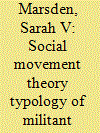

|
|
|
|
|
| Summary/Abstract |
Typologies are ubiquitous in terrorism studies, illustrating their continued appeal as a tool to further our understanding of this form of political violence. Despite this, to date, the promise of an empirically derived typology has largely been neglected. In addressing this gap, this article sets out a typology developed from Social Movement Theory. Using a novel statistical technique to derive a three-dimensional framework for categorising militant groups, the typology incorporates both organisational characteristics and the wider political context. The result is a typology defined by three conceptual constructs: political capacity, war-making capacity, and network capacity. Alongside these organisational features, imposing measures of the wider political opportunity structure reveals eight types of militant organisation. To explore the utility of the framework, a preliminary analysis interprets the typology in light of the presence of wider conflict. That a robust relationship is found between the various types and whether groups were operating in peacetime, civil war, or low-intensity conflict, goes some way to demonstrating its utility as an analytical tool. Conclusions draw attention to the importance of contextualising militant groups in their socio-political setting, and the benefits of combining theory alongside empirical analysis to develop robust characterisations of violent organisations.
|
|
|
|
|
|
|
|
|
|
|
|
|
|
|
|
| 20 |
ID:
106573
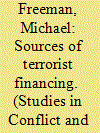

|
|
|
|
|
| Publication |
2011.
|
| Summary/Abstract |
Terrorism costs money. Although the costs of specific operations may be relatively inexpensive, terrorist organizations require much larger budgets in order to function. But how do terrorist groups acquire funding? What explains the variation in the particular sources used by different groups? This article develops a theory of terrorist financing that identifies criteria by which we can evaluate the different sources of terrorist funding, particularly in terms of their advantages and disadvantages to the terrorist group. These criteria are then applied across a typology of four primary types of terrorist financing: state sponsorship, illegal activity, legal activity, and popular support.
|
|
|
|
|
|
|
|
|
|
|
|
|
|
|
|
|
|
|
|
|